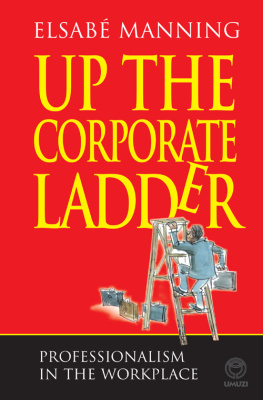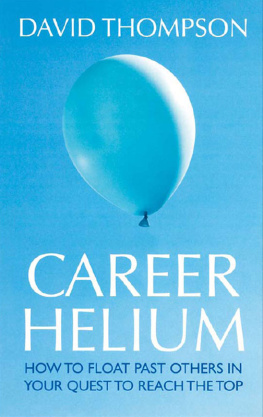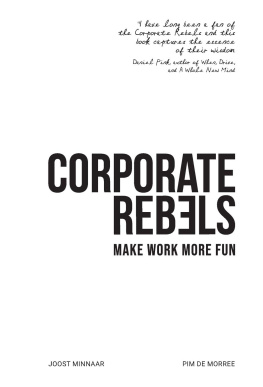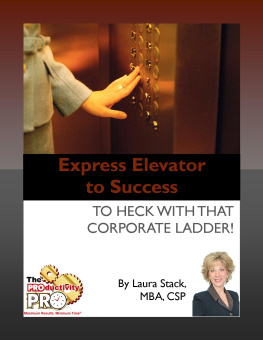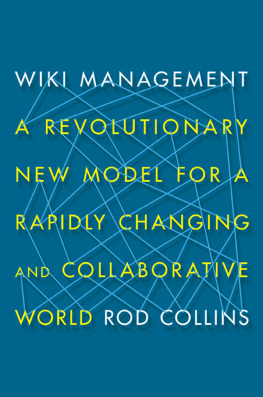ACKNOWLEDGMENTS
Gratitude is the hearts memory.
B. Ellis
A CTIONS ARE THE TRUEST MEASURE of intent. This work benefited greatly from the support of the many business leaders, researchers, academics, and professionals who opened their schedules to share their experiences and insights. Your generosity signifies the relevance of the changing world of work, and your candor added depth and rich examples of practical application. We hold you in the highest esteem.
To move from concept to action requires bold leadership. Its humbling to experience how a remarkable leadership team, led by Barry Salzberg and Sharon Allen, overturned long-held workplace beliefs and not only embraced the notion of a lattice organization, but shepherded its adoption, driving the change.
Weve had the privilege of collaborating with an extraordinary community that first came together to embrace the principles and framework outlined in Mass Career Customization. You were the risk takers and the trailblazers, believing before the evidence. The ideas and observations of the lattice organization emerged during this collaboration, and this prequel is in many ways a tribute to your efforts.
We applaud our colleagues who contributed in so many ways. Partnership works, and the whole is surely greater than the sum of any individuals contributions. A special thank-you to Barbara Adachi, Andy Liakopoulos, and Jeff Schwartz, who profoundly influenced this effort both directly and indirectly.
Special recognition goes to our key collaborators, whose zeal, good humor, and sharp intellects inspired and sustained us:
To Mickey Buttsyour eye for the flow of logic and skill for refining the written word is evident on every page.
To Suzanne MacGibbonyour doggedness in crafting, challenging, and clarifying ideas made a lasting contribution.
To Laura Stokkeryou have the heart of a lion and have mastered both the art and science of project management. This work is stronger as a result of it.
To Anne Weisbergthe thesis of this book extends from our earlier works; we appreciate your contributions to all.
Thanks also to Jackie Boyle, Maggie Chao, Jennifer Clarke, Karen Crandall, and Suzanne Vickberg: you were an integral part of bringing this work to fruition. To Dave Gershenson, Suzanne Gylfe, Ken Horner, Mary McGoff, and the TEG: we appreciate the critical eye. And our thanks as well to all those who lent a helping hand, whether it was taking on more of the work of our day jobs, tracking down research studies, crafting graphics, or offering to pitch in on the home front. Your generosity fueled us.
Our heartfelt appreciation also goes to the many others, some anonymous and others not, who contributed through blog posts and other means: your views surely enhanced our thinking. Our thanks as well to our editor, Jacque Murphy, who has a knack for helping to shape our views and keep us on task.
Finally, well, theres no place like home. From Cathy: To George, Brendan, and Ellie, your unwavering support and personal sacrifices in support of this project, and indeed the broader base of my professional pursuits, mean the world to me. From Molly: To Richard, Emily, and Matthew, I am deeply grateful for your bottomless well of support and sacrifice. You are my heart and my joy, and you inspire me every day.
______________
In the spirit of Friedrich Engels, who said, An ounce of action is worth a ton of theory, its now time to get to work exploring ways to make sense of and respond to the change thats all around us in a concerted and deliberate fashion.
Also by Cathleen Benko:
Cathleen Benko and Anne Weisberg,
Mass Career Customization:
Aligning the Workplace with Todays
Nontraditional Workforce
Cathy Benko is Vice Chairman and Chief Talent Officer at Deloitte LLP, the largest professional services firm in the United States. In this role, Cathy sets the strategy and leads the delivery of Deloittes signature talent experience to a highly skilled and diverse workforce. She is a leading authority on talent strategies and transformational change to achieve exceptional results. Previously, she served as Deloitte Consulting LLPs global e-business leader and subsequently led the high-technology industry sector as well as the organizations award-winning Womens Initiative.
Cathy has been named a Frontline Leader by Consulting magazine and is the recipient of its inaugural Leadership Achievement Award for Women Leaders. She also has been cited by a number of prestigious organizations, including Women in Technology International (WITI) and the San Francisco Business Times, which has named her one of the Most Influential Women in the Bay Area for eight consecutive years.
Cathy is coauthor of the bestseller Mass Career Customization: Aligning the Workplace with Todays Nontraditional Workforce (Harvard Business Press, 2007) and Connecting the Dots: Aligning Projects with Objectives in Unpredictable Times (Harvard Business Press, 2003). Her byline and other contributed insights have appeared in such publications as the New York Times,Ivey Business Journal,Strategy + Leadership,BusinessWeek, the Wall Street Journal,Time,Workforce Management, and other national media outlets, including major television business and news channels.
Cathy serves on Deloitte LLPs executive committee and global talent council. She is a member of Consulting Magazines advisory board and the Western Advisory Council for Catalyst and was recently a judge for Harvard Business Reviews McKinsey Awards. Cathy earned her MBA from Harvard Business School and lives in Northern California with her husband and two children.
Molly Anderson is Director of Talent for Deloitte Services LP, specializing in innovative strategies to engage todays increasingly diverse, knowledge-based workforce. She designed and led the implementation of Mass Career Customization across Deloittes forty-three-thousand-person organization, significantly increasing career-life satisfaction, retention, and engagement.
Prior to her current role, Molly directed Deloittes highly acclaimed Womens Initiative, leading programs to advance women through leadership development, innovation, community building, and marketplace eminence.
Molly is an authority on organizational effectiveness, human resources strategy, and learning and development. She has extensive experience implementing transformational change in large organizations through the integration of processes, people, and technology. Her expertise spans a range of industries and disciplines including health care, higher education, mergers and acquisitions, and customer service.
Molly is a frequent speaker on these topics in forums for the Conference Board, the Professional BusinessWomen of California, Stanford University, the University of California, and corporate leadership groups in a variety of industries.
Molly earned her MBA from Stanford University and her undergraduate degree from Harvard University. She lives with her husband and two children in Northern California.
The future has already arrived.
Its just not evenly distributed yet.
William Gibson
T HE WORLD OF WORK is at an inflection point. The hierarchical corporate ladder is giving way to a multidimensional corporate lattice.
Firmly rooted in the industrial age, the corporate ladder has been the prevailing paradigm for how an enterprise is organized and how it manages its work and people. At its heart, the ladder depends on an inflexible organizational worldview in which prestige, rewards, information access, and power are tied to the rung an employee occupies. Its one-size-fits-all approach assumes that employees are more alike than different. The ladder is built on a top-down, 9-to-5 notion of when, where, and how work gets done. It defines career success as a linear climb to the top.



